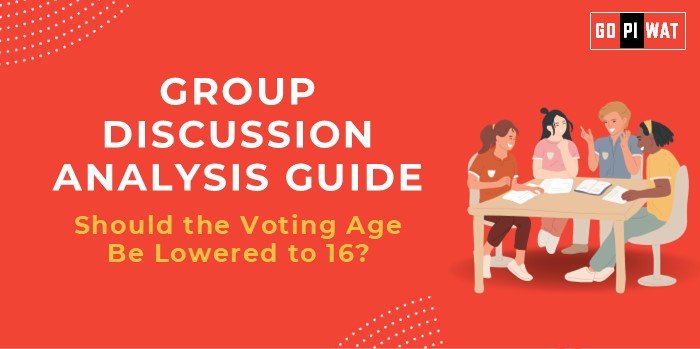📋 Group Discussion Analysis Guide: Should the Voting Age Be Lowered to 16?
🌐 Introduction to the Topic
- 📖 Opening Context: The question of lowering the voting age to 16 has sparked global debate, with some countries adopting this measure while others remain cautious. In India, where over 50% of the population is below 25, this topic holds immense relevance as it ties into the broader discourse on youth engagement in democracy.
- 🌍 Topic Background: The voting age in India was reduced from 21 to 18 in 1989, making it one of the first nations to recognize the political agency of younger citizens. Advocates argue that today’s 16-year-olds are more informed and engaged than ever, while critics question their maturity and readiness to make informed decisions.
📊 Quick Facts and Key Statistics
- 👥 Youth Population in India: Over 253 million aged 15-24 (UN, 2023) – underscores the demographic potential.
- 🌏 Countries Allowing Voting at 16: Austria, Scotland, Brazil – showcases international precedents.
- 📱 Internet Penetration in Indian Youth: 67% (IAMAI, 2023) – reflects accessibility to information.
- 🗳️ Youth Participation in Politics: 18% of Indian voters aged 18-25 (ECI, 2023) – indicates significant involvement.
🤝 Stakeholders and Their Roles
- 🏛️ Government: Responsible for amending electoral laws and ensuring voter education for younger demographics.
- 📢 Youth Advocacy Groups: Drive campaigns highlighting the capacity and readiness of 16-year-olds.
- 🎓 Educational Institutions: Key in fostering civic literacy and democratic values in students.
- ⚖️ Election Commission of India (ECI): Oversees the operational feasibility of including 16-year-olds in electoral rolls.
- 👨👩👧 Parents and Guardians: Play a role in shaping early political understanding and engagement.
🏆 Achievements and Challenges
✨ Achievements:
- ✅ Global Precedents: Austria successfully implemented voting at 16 in 2007, reporting increased youth participation.
- 📢 Political Awareness Among Youth: Social media and online platforms have significantly increased young people’s exposure to political discourse.
- 📚 Civic Engagement Programs: Initiatives like India’s NSS promote democratic values among the youth.
⚠️ Challenges:
- 🧠 Maturity Concerns: Critics question whether 16-year-olds possess the emotional and cognitive maturity to vote responsibly.
- 📖 Educational Disparities: Uneven access to civic education across rural and urban areas may lead to uninformed voting.
- 📉 Global Comparisons: In countries like Brazil, while voting is allowed at 16, turnout among young voters remains low, raising questions about practical engagement.
📄 Case Studies:
- 📌 Austria: Reports higher voter turnout in 16-17 age group compared to older youth.
- 📌 India: Historical success of reducing the voting age to 18 in 1989 demonstrated increased youth engagement.
💡 Structured Arguments for Discussion
- 📢 Supporting Stance: “Lowering the voting age to 16 empowers young people to shape policies that directly impact their future.”
- ❌ Opposing Stance: “At 16, individuals may lack the maturity and life experience required for informed voting.”
- ⚖️ Balanced Perspective: “While lowering the voting age fosters early engagement, its success depends on robust civic education programs.”
📌 Effective Discussion Approaches
🎯 Opening Approaches:
- 📖 Historical Context: “India’s decision to lower the voting age in 1989 was a landmark move; could 16 be the next step?”
- 📊 Data-Driven Start: “With over 67% of Indian youth connected to the internet, are today’s 16-year-olds more informed than ever?”
- 🌍 Global Precedent: “Countries like Austria have shown that voting at 16 increases youth turnout. Can India replicate this?”
🔄 Counter-Argument Handling:
- 📖 Acknowledge concerns about maturity; propose solutions like mandatory civic education.
- 📱 Address fears of uninformed voting by highlighting the role of digital platforms in disseminating information.
📚 Strategic Analysis of Strengths and Weaknesses
- 💪 Strengths:
- 📋 Youth representation.
- 📈 Increased voter base.
- 🌟 Potential for early political engagement.
- ❌ Weaknesses:
- 🧠 Maturity doubts.
- 📉 Educational inequality.
- ✨ Opportunities:
- 📱 Leveraging technology for civic literacy.
- 🌍 Aligning with global democratic trends.
- ⚠️ Threats:
- 📢 Political exploitation.
- 📖 Disengagement due to lack of education.
🎓 Connecting with B-School Applications
🌐 Real-World Applications:
- 📊 Study the impact of youth engagement on public policy frameworks.
❓ Sample Interview Questions:
- ❓ “What are the potential challenges of lowering the voting age in a diverse country like India?”
- 💡 “How can technology be leveraged to prepare 16-year-olds for voting responsibilities?”
📈 Insights for Students:
- 📖 Examine youth-driven policy advocacy in India.
- 🤝 Explore public-private partnerships in civic education initiatives.


